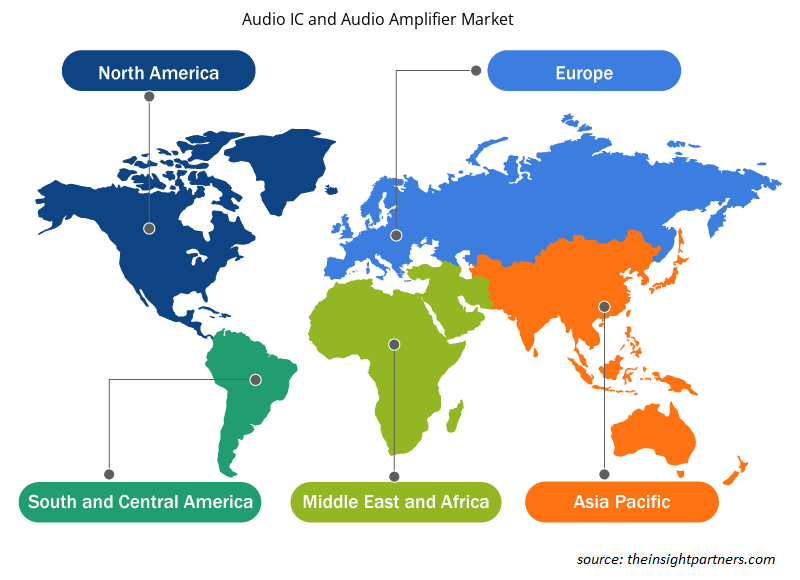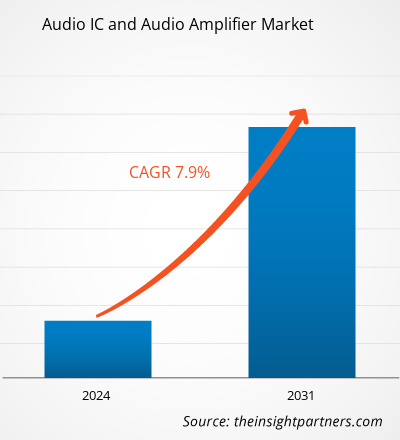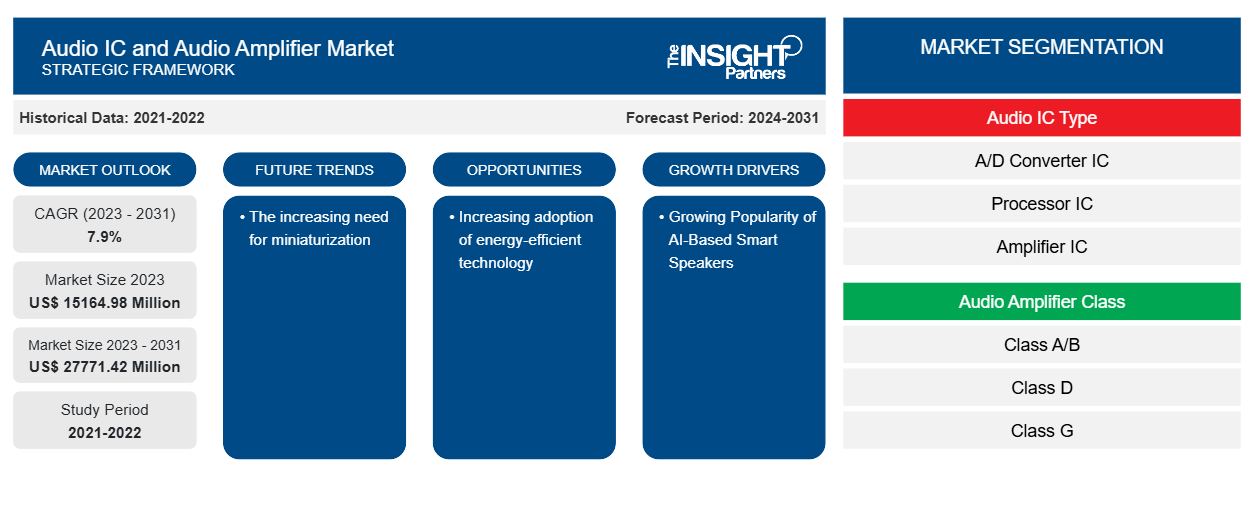Der Markt für Audio-ICs und Audioverstärker soll von 15.164,98 Millionen US-Dollar im Jahr 2023 auf 27.771,42 Millionen US-Dollar im Jahr 2031 anwachsen. Der Markt soll zwischen 2023 und 2031 eine durchschnittliche jährliche Wachstumsrate (CAGR) von 7,9 % verzeichnen. Der zunehmende Bedarf an Miniaturisierung dürfte ein wichtiger Trend auf dem Markt bleiben.
Marktanalyse für Audio-ICs und Audioverstärker
Der Markt für Audio-integrierte Schaltkreise und Audioverstärker wächst aufgrund der Verbraucherpräferenzen für eine vernetzte Welt und der Notwendigkeit der Verkleinerung. Die Funktion eines Verstärkers besteht darin, Signalschwingungen zu maximieren, ohne Frequenz oder Wellenlänge zu beeinflussen und so die Gesamteffizienz des Audiosystems zu verbessern. Darüber hinaus wird die Verkleinerung elektronischer Geräte, neben anderen neuen Trends, durch strenge staatliche Vorschriften zum Umweltschutz und die zunehmende Einführung energieeffizienter Technologien unterstützt. Das hohe verfügbare Einkommen der arbeitenden Bevölkerung und der technologische Fortschritt werden voraussichtlich ebenfalls das Marktwachstum ankurbeln.
Marktübersicht für Audio-ICs und Audioverstärker
Zahlreiche elektronische Geräte wie Mobiltelefone, PCs, Autoradios und Heimkinos verwenden integrierte Schaltkreise für Audioverstärker. Die Audioausgabe dieser Geräte wäre ohne diese Chips wesentlich schwächer und schwerer zu hören. IC-Chips für Audioverstärker sind in vielen Formen und Größen erhältlich, jeder mit einer bestimmten Funktion. Während einige dazu gedacht sind, Signale mit geringer Leistung zu verstärken, sind andere dazu gedacht, Signale mit hoher Leistung zu verstärken. Während einige dazu gedacht sind, Signale über einen breiten Frequenzbereich zu verstärken, sind andere dazu gedacht, dies nur innerhalb eines bestimmten Frequenzbereichs zu tun.
Passen Sie diesen Bericht Ihren Anforderungen an
Sie erhalten kostenlose Anpassungen an jedem Bericht, einschließlich Teilen dieses Berichts oder einer Analyse auf Länderebene, eines Excel-Datenpakets sowie tolle Angebote und Rabatte für Start-ups und Universitäten.
-
Holen Sie sich die wichtigsten Markttrends aus diesem Bericht.Dieses KOSTENLOSE Beispiel umfasst eine Datenanalyse von Markttrends bis hin zu Schätzungen und Prognosen.
Treiber und Chancen auf dem Markt für Audio-ICs und Audioverstärker
Wachsende Popularität von KI-basierten Smart Speakern
Smart Speaker sind nicht nur mit Bluetooth- und WLAN-Netzwerkoptionen ausgestattet, die eine freihändige Aktivierung und interaktive Funktionen wie Musikwiedergabe, Sprachinteraktion, tägliche Aktivitätsverfolgung, Nachrichten-Streaming und Wettervorhersage ermöglichen, sondern verfügen auch über Sprachbefehlserkennung und virtuelle Unterstützung. Dank KI-Unterstützung und Netzwerktechnologien können Benutzer Smart Speaker verwenden, um ihre Heimautomatisierungssysteme zu steuern. Der zunehmende Trend zu Smart Speakern mit KI-Funktionen treibt den Markt für Audio-ICs und Audioverstärker an. Der Verkauf von KI-basierten Smart Speakern wird von einer Reihe von Faktoren angetrieben, darunter die wachsende Nachfrage nach Smart Speakern mit Anzeigefunktionen, die wachsende Vorliebe für Smart Homes mit opulenten Unterhaltungssystemen und die Vorliebe der Menschen für multifunktionale Geräte. Diese Faktoren sowie das steigende Pro-Kopf-Einkommen der Bevölkerung weltweit treiben den Markt ebenfalls an.
Zunehmende Nutzung energieeffizienter Technologien
Professionelle Soundsysteme, wie sie in Veranstaltungsorten wie Stadien, Theatern, Kinos und Nachtclubs verwendet werden, benötigen enorme Leistung, um den Ton für ihr Publikum zu verstärken. In diesen Fällen bieten Audiolösungen mit energieeffizienter Technologie die Möglichkeit, den Energieverbrauch, die Wärmeableitung und den gesamten ökologischen Fußabdruck zu reduzieren, während das resultierende akustische Erlebnis weiterhin das beste seiner Klasse bleibt. Die zunehmende Einführung energieeffizienter Technologie schafft also mehr Möglichkeiten für den Markt.
Segmentierungsanalyse des Marktberichts für Audio-ICs und Audioverstärker
Wichtige Segmente, die zur Ableitung der Marktanalyse für Audio-ICs und Audioverstärker beigetragen haben, sind Audio-IC-Typ und Audioverstärkerklasse.
- Basierend auf dem Audio-IC-Typ ist der Markt für Audio-ICs und Audioverstärker in A/D-Wandler-ICs, Prozessor-ICs, Verstärker-ICs, D/A-Wandler-ICs und andere unterteilt. Das Lösungssegment hatte im Jahr 2023 einen größeren Marktanteil.
- Nach Bereitstellungsmodus ist der Markt in Klasse A/B, Klasse D, Klasse G und Klasse H segmentiert. Das Cloud-Segment hatte im Jahr 2023 einen größeren Marktanteil.
Audio-IC- und Audioverstärker-Marktanteilsanalyse nach geografischer Lage
Der geografische Umfang des Marktberichts für Audio-ICs und Audioverstärker ist hauptsächlich in fünf Regionen unterteilt: Nordamerika, Asien-Pazifik, Europa, Naher Osten und Afrika sowie Süd- und Mittelamerika.
APAC dominiert den Markt für Audio-ICs und Audioverstärker. Der Markt für Audio-ICs und Audioverstärker in dieser Region wächst aufgrund verschiedener Faktoren, wie z. B. zunehmender staatlicher Initiativen zum Umweltschutz und der Einführung energieeffizienter Technologien.
Regionale Einblicke in den Markt für Audio-ICs und Audioverstärker
Die regionalen Trends und Faktoren, die den Markt für Audio-ICs und Audioverstärker im Prognosezeitraum beeinflussen, wurden von den Analysten von Insight Partners ausführlich erläutert. In diesem Abschnitt werden auch die Marktsegmente und die Geografie von Audio-ICs und Audioverstärkern in Nordamerika, Europa, im asiatisch-pazifischen Raum, im Nahen Osten und Afrika sowie in Süd- und Mittelamerika erörtert.

- Erhalten Sie regionale Daten zum Audio-IC- und Audioverstärker-Markt
Umfang des Marktberichts zu Audio-ICs und Audioverstärkern
| Berichtsattribut | Details |
|---|---|
| Marktgröße im Jahr 2023 | 15.164,98 Millionen US-Dollar |
| Marktgröße bis 2031 | 27771,42 Millionen US-Dollar |
| Globale CAGR (2023 - 2031) | 7,9 % |
| Historische Daten | 2021-2022 |
| Prognosezeitraum | 2024–2031 |
| Abgedeckte Segmente |
Nach Audio-IC-Typ
|
| Abgedeckte Regionen und Länder |
Nordamerika
|
| Marktführer und wichtige Unternehmensprofile |
|
Marktdichte von Audio-ICs und Audio-Verstärkern: Auswirkungen auf die Geschäftsdynamik verstehen
Der Markt für Audio-ICs und Audioverstärker wächst rasant. Dies wird durch die steigende Nachfrage der Endnutzer aufgrund von Faktoren wie sich entwickelnden Verbraucherpräferenzen, technologischen Fortschritten und einem größeren Bewusstsein für die Vorteile des Produkts vorangetrieben. Mit der steigenden Nachfrage erweitern Unternehmen ihr Angebot, entwickeln Innovationen, um die Bedürfnisse der Verbraucher zu erfüllen, und nutzen neue Trends, was das Marktwachstum weiter ankurbelt.
Die Marktteilnehmerdichte bezieht sich auf die Verteilung der Firmen oder Unternehmen, die in einem bestimmten Markt oder einer bestimmten Branche tätig sind. Sie gibt an, wie viele Wettbewerber (Marktteilnehmer) in einem bestimmten Marktraum im Verhältnis zu seiner Größe oder seinem gesamten Marktwert präsent sind.
Die wichtigsten Unternehmen auf dem Markt für Audio-ICs und Audioverstärker sind:
- IC Audio GmbH
- ICEpower A/S
- Infineon Technologies AG
- Maxim Integrated
- NXP Semiconductors NV
- Renesas Electronics Corporation
Haftungsausschluss : Die oben aufgeführten Unternehmen sind nicht in einer bestimmten Reihenfolge aufgeführt.

- Überblick über die wichtigsten Akteure auf dem Markt für Audio-ICs und Audioverstärker
Neuigkeiten und aktuelle Entwicklungen auf dem Audio-IC- und Audioverstärkermarkt
Der Markt für Audio-ICs und Audioverstärker wird durch die Erhebung qualitativer und quantitativer Daten nach Primär- und Sekundärforschung bewertet, die wichtige Unternehmensveröffentlichungen, Verbandsdaten und Datenbanken umfasst. Nachfolgend sind einige der Entwicklungen auf dem Markt für Audio-ICs und Audioverstärker aufgeführt:
- STMicroelectronics (NYSE: STM), ein weltweit führendes Halbleiterunternehmen, das Kunden aus dem gesamten Spektrum elektronischer Anwendungen bedient, hat den neuen FDA901 Class-D-Audioverstärker-IC angekündigt, dessen Halbleiterdesign die erstklassige Audiodesign-Expertise von Alps Alpine Co., Ltd., einem bedeutenden japanischen Hersteller von Auto-Audiogeräten und Informationskommunikationsgeräten, beinhaltet . Der neue Chip soll zur Schaffung von Multifunktionalität beitragen. Diese Hi-Fi-Auto-Audiosysteme vereinen die hohe Effizienz von Class-D-Verstärkern mit dem hochwertigen Klang der Class-AB-Verstärker von ST. (Quelle: STMicroelectronics, Pressemitteilung, März 2020)
- STMicroelectronics (NYSE: STM), ein weltweit führendes Halbleiterunternehmen, das Kunden aus dem gesamten Spektrum elektronischer Anwendungen bedient, gab die Übernahme und Integration der Vermögenswerte von SOMOS Semiconductor („SOMOS“) bekannt. SOMOS mit Sitz in Marly-le-Roy (Frankreich) ist ein 2018 gegründetes Fabless-Halbleiterunternehmen, das auf siliziumbasierte Leistungsverstärker und RF-Front-End-Module (FEM)-Produkte spezialisiert ist. (Quelle: STMicroelectronics, Pressemitteilung, Oktober 2020)
Marktbericht zu Audio-ICs und Audioverstärkern – Abdeckung und Ergebnisse
Der Bericht „Marktgröße und Prognose für Audio-ICs und Audioverstärker (2021–2031)“ bietet eine detaillierte Analyse des Marktes, die die folgenden Bereiche abdeckt:
- Marktgröße und Prognose für Audio-ICs und Audioverstärker auf globaler, regionaler und Länderebene für alle wichtigen Marktsegmente, die im Rahmen des Berichts abgedeckt sind
- Markttrends für Audio-ICs und Audioverstärker sowie Marktdynamiken wie Treiber, Einschränkungen und wichtige Chancen
- Detaillierte PEST/Porters Five Forces- und SWOT-Analyse
- Marktanalyse für Audio-ICs und Audioverstärker, die wichtige Markttrends, globale und regionale Rahmenbedingungen, wichtige Akteure, Vorschriften und aktuelle Marktentwicklungen umfasst
- Branchenlandschaft und Wettbewerbsanalyse, die die Marktkonzentration, Heatmap-Analyse, prominente Akteure und aktuelle Entwicklungen für den Markt für Audio-ICs und Audioverstärker umfasst
- Detaillierte Firmenprofile
- Historische Analyse (2 Jahre), Basisjahr, Prognose (7 Jahre) mit CAGR
- PEST- und SWOT-Analyse
- Marktgröße Wert/Volumen – Global, Regional, Land
- Branchen- und Wettbewerbslandschaft
- Excel-Datensatz
Aktuelle Berichte
Verwandte Berichte
Erfahrungsberichte
Grund zum Kauf
- Fundierte Entscheidungsfindung
- Marktdynamik verstehen
- Wettbewerbsanalyse
- Kundeneinblicke
- Marktprognosen
- Risikominimierung
- Strategische Planung
- Investitionsbegründung
- Identifizierung neuer Märkte
- Verbesserung von Marketingstrategien
- Steigerung der Betriebseffizienz
- Anpassung an regulatorische Trends























 Kostenlose Probe anfordern für - Markt für Audio-ICs und Audioverstärker
Kostenlose Probe anfordern für - Markt für Audio-ICs und Audioverstärker